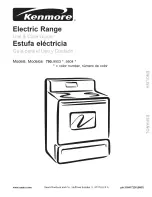
16
Cleaning the self-cleaning surfaces in the cooking
compartment
The back wall in the cooking compartment is coated with a
highly porous ceramic layer. This coating absorbs and
disintegrates splashes from baking and roasting while the oven
is in operation. The higher the temperature and the longer the
oven is in operation, the better the result will be.
If splashes are still visible even after repeated use, proceed as
follows:
1.
Clean the floor, ceiling and side panels of the cooking
compartment thoroughly.
2.
Set
:
3D hot air.
3.
With the door closed, heat up the empty oven for
approximately 2 hours at maximum temperature.
The ceramic coating is regenerated. When the cooking
compartment has cooled down, remove the brown or white
residue with water and a soft sponge.
Light discolouration of the coating does not affect automatic
self-cleaning.
Caution!
■
Never use abrasive cleaning agents. You will scratch or
destroy the highly porous coating.
■
Never treat the ceramic coating with oven cleaner. If oven
cleaner accidentally gets onto it, remove it immediately with a
sponge and plenty of water.
Cleaning the cooking compartment floor, ceiling and side
walls
Use a dish cloth and hot soapy water or a vinegar solution.
If there are heavy deposits of dirt, use a stainless steel scouring
pad or oven cleaner. Only use when the cooking compartment
is cold. Never treat the self-cleaning surfaces with a scouring
pad or oven cleaner.
Detaching and refitting the rails
The rails can be removed for cleaning. The oven must have
cooled down.
Detaching the rails
1.
Lift up the front of the rail
2.
and unhook it (figure A).
3.
Then pull the whole rail forward
4.
and remove it (Fig. B).
Clean the rails with cleaning agent and a sponge. For stubborn
deposits of dirt, use a brush.
Refitting the rails
1.
First insert the rail into the rear socket, press it to the back
slightly (figure A),
2.
and then hook it into the front socket (figure B).
The rails fit both the left and right sides. Ensure that, as shown
in figure B, levels 1 and 2 are below and levels 3, 4 and 5 are
above.
Detaching and attaching the oven door
For cleaning purposes and to remove the door panels, you can
detach the oven door.
The oven door hinges each have a locking lever. When the
locking levers are closed (figure A), the oven door is secured in
place. It cannot be detached. When the locking levers are open
in order to detach the oven door (Fig. B), the hinges are locked.
They cannot snap shut.
Glass cover on the
oven light
Wipe with some washing-up liquid and a damp cloth. Dry with a soft cloth.
Accessories
Soak in hot soapy water. Clean with a brush or a sponge.
Aluminium baking
tray (option)
Do not clean in the dishwasher. Never use oven cleaner. To avoid scratches, never touch the metal sur-
faces with a knife or similar sharp object. Clean horizontally with some washing-up liquid and a damp glass
cleaning cloth or a microfibre cloth. Dry with a soft cloth. Do not use any abrasive materials, scouring
sponges or rough cleaning cloths. They could scratch the baking tray
Childproof lock
(option)
If a childproof lock has been fitted on the oven door, it must be removed before cleaning. Soak all plastic
parts in hot soapy water and wash with a sponge. Dry with a soft cloth. If very dirty, the childproof lock will
not work properly.
Plinth drawer
(option)
Wipe with some washing-up liquid and a damp cloth. Dry with a soft cloth.
Accessories
Soak in hot soapy water. Clean with a brush or sponge.
%
$
%
$
%
$













































